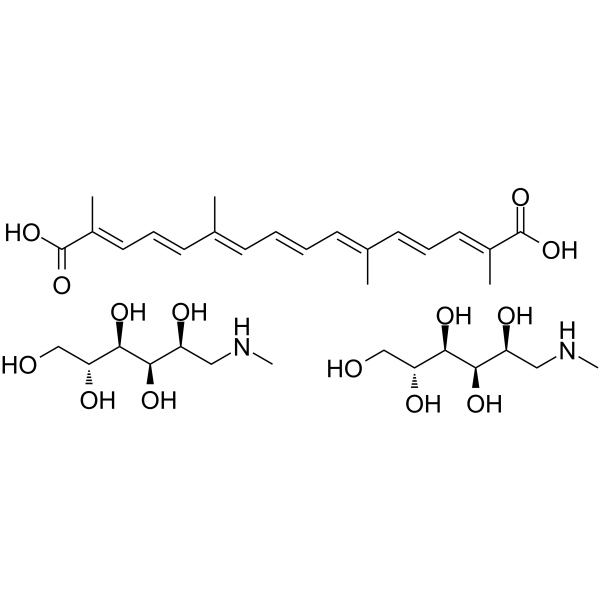上海金畔生物科技有限公司提供天然产物萜类及其苷类Terpenoids and Glycosides。
Transcrocetin meglumine salt (Synonyms: trans-Crocetin meglumine salt) 纯度: 99.28%
Transcrocetin meglumine salt 从藏红花 (Crocus sativus L.) 中提取的,是一种高亲和力的 NMDA 受体拮抗剂。

Transcrocetin meglumine salt Chemical Structure
| 规格 | 价格 | 是否有货 | 数量 |
|---|---|---|---|
| Free Sample (0.1-0.5 mg) | Apply now | ||
| 10 mM * 1 mL in DMSO | ¥2451 | In-stock | |
| 5 mg | ¥1550 | In-stock | |
| 10 mg | ¥2850 | In-stock | |
| 25 mg | ¥5800 | In-stock | |
| 50 mg | 询价 | ||
| 100 mg | 询价 |
* Please select Quantity before adding items.
Transcrocetin meglumine salt 相关产品
•相关化合物库:
- Natural Product Library Plus
- Drug Repurposing Compound Library Plus
- Clinical Compound Library Plus
- Bioactive Compound Library Plus
- Membrane Transporter/Ion Channel Compound Library
- Neuronal Signaling Compound Library
- Natural Product Library
- Anti-Cancer Compound Library
- Clinical Compound Library
- Drug Repurposing Compound Library
- Medicine Food Homology Compound Library
- Terpenoids Library
- Neurotransmitter Receptor Compound Library
- Anti-Alzheimer’s Disease Compound Library
- Neuroprotective Compound Library
- Anti-Parkinson’s Disease Compound Library
- Neurodegenerative Disease-related Compound Library
- Food-Sourced Compound Library
| 生物活性 |
Transcrocetin meglumine salt, extracted from saffron (Crocus sativus L.), acts as an NMDA receptor antagonist with high affinity. |
IC50 & Target |
NMDA receptor[1] |
||||||||||||||
|---|---|---|---|---|---|---|---|---|---|---|---|---|---|---|---|---|---|
| 体外研究 (In Vitro) |
Transcrocetin (trans-Crocetin), a saffron metabolite originating from the crocin apocarotenoids, has been shown to exert strong NMDA receptor affinity and is thought to be responsible for the CNS activity of saffron.To ensure unchanged viability of Caco-2 cells throughout the transport experiments, cellular mitochondrial dehydrogenase activity of Caco-2 cells is measured by MTT assay after a 24 h incubation period with the test compounds: Hydroalcoholic saffron extract saffron extract (SE, 0.5-1 mg/mL) and crocin-1 (250-1000 µM) reveal no negative significant changes in cellular viability. Transcrocetin at 10 µM level does not change viability while higher concentrations (40-160 µM) reduces significantly cellular viability[1]. Shanghai Jinpan Biotech Co Ltd has not independently confirmed the accuracy of these methods. They are for reference only. |
||||||||||||||||
| Clinical Trial |
|
||||||||||||||||
| 分子量 |
718.83 |
||||||||||||||||
| Formula |
C34H58N2O14 |
||||||||||||||||
| 运输条件 |
Room temperature in continental US; may vary elsewhere. |
||||||||||||||||
| 储存方式 |
4°C, sealed storage, away from moisture *In solvent : -80°C, 6 months; -20°C, 1 month (sealed storage, away from moisture) |
||||||||||||||||
| 溶解性数据 |
In Vitro:
DMSO : 8.33 mg/mL (11.59 mM; ultrasonic and warming and heat to 66°C) 配制储备液
*
请根据产品在不同溶剂中的溶解度选择合适的溶剂配制储备液;一旦配成溶液,请分装保存,避免反复冻融造成的产品失效。 In Vivo:
请根据您的实验动物和给药方式选择适当的溶解方案。以下溶解方案都请先按照 In Vitro 方式配制澄清的储备液,再依次添加助溶剂: ——为保证实验结果的可靠性,澄清的储备液可以根据储存条件,适当保存;体内实验的工作液,建议您现用现配,当天使用; 以下溶剂前显示的百
|
||||||||||||||||
| 参考文献 |
|
| Cell Assay [1] |
Cytotoxicity of test compounds is determined by MTT assay using Caco-2 cells in 96 well plates at a density of 20.000 cells per well in 200 µl FBS-free medium, grown for 96 h and followed by 24 h contact time with the test compounds (100 µL of serum-free media containing SE 0.5, 1, and 2 mg/mL; trans-crocin-1 250, 500, and 1000 µM; Transcrocetin 10, 40, 80, and 160 µM) and incubation at 37°C/5% CO2. The incubation solutions are aspirated, each well is washed twice with 150 µL of PBS and 50 µL of MTT solution are added (2.5 mg/mL in PBS). Supernatants are discarded and the formed formazan is dissolved in 50 µL of DMSO. The absorption of the resulting solution is determined at λ=492 nm against reference wavelength λ=690 nm[1]. Shanghai Jinpan Biotech Co Ltd has not independently confirmed the accuracy of these methods. They are for reference only. |
|---|---|
| 参考文献 |
|
